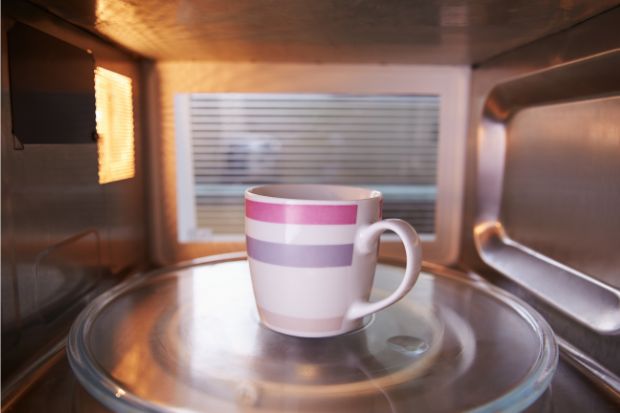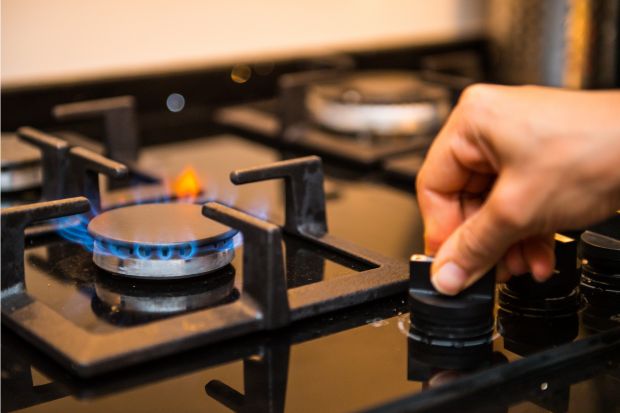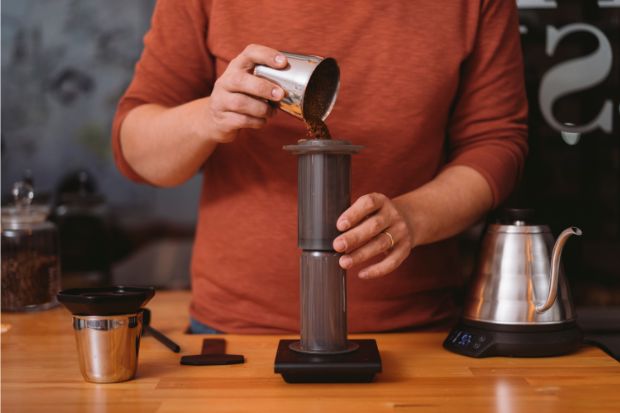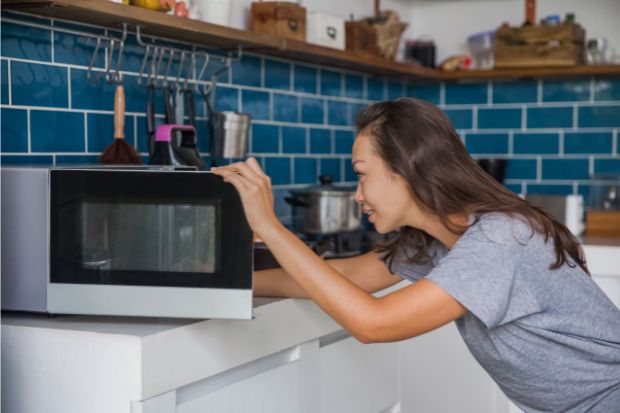Just so you know, as an Amazon Associate we earn from qualifying purchases made via bold red links, buttons or images.
Last Updated on December 15, 2023
In this article, I’ll tell you why reheated coffee tastes so bad, the best way to reheat coffee if you absolutely have to, and some alternatives you might want to try out instead.
I’m a French press gal, and I often make an entire large Bodum to get me through the morning. Even on a good day, I rarely get to the bottom while it’s still hot. I’m guilty of reheating that leftover coffee, and although it still gets the job done, it’s never as enjoyable as that first cup of hot coffee. Reheating coffee isn’t harmful, but it’s definitely not ideal.
Why Does Reheated Coffee Taste So Bad?

Regardless of how you reheat your coffee, you’ll probably notice that it tastes far more bitter than when it was first brewed. Well, it actually is. It’s science! Coffee beans contain acids.
The acid in green coffee beans is primarily chlorogenic acid. When heat is added to the beans, first through the roasting process, this chlorogenic acid turns into caffeic and quinic acids. The latter two acids are more acidic than their chlorogenic ester, and impart more bitterness. This is why darker roasts tend to have more bitterness than medium roasts as they are subjected to heat for longer. Every time you add heat to your coffee this process occurs, ramping up the bitterness bit by bit. When you reheat brewed coffee you’ll always end up with the most bitter iteration.
This chemical reaction is only part of the equation. Your coffee is made up of these acids, as well as volatile compounds. These compounds, such as antioxidants, diterpenes, and of course caffeine, all contribute to your coffee’s distinct and enticing aromas.
Caffeine itself adds some bitterness to all coffee, but luckily it’s the most stable of the bunch. So the good news is that reheating your coffee does not affect its caffeine level. The bad news is that the less-stable compounds are constantly undergoing chemical reactions and releasing those pleasant aromas into the air. The more you heat your coffee, the more aromas you lose.
This, combined with the increase in bitterness, is why your reheated coffee often tastes much worse than when it was first brewed.
How To Reheat Coffee (If You Must)

I live by the age-old philosophy of waste not, want not. It’s extremely rare for anything to go down the drain under my watch. If you’re the same way, or just want to get the most out of every pot of coffee, what’s the best way to reheat it?
Well, there’s a lot of conflicting information floating around about this one, but I think I got to the heart of it.
Many people claim that slowly heating on the stovetop is best, but I’ve seen little follow up or reasoning given. Now, I swore off microwaves over a decade ago. I reheat everything on the stovetop. It’s just my way. It does seem, however, that the microwave is actually the best choice for minimizing both bitterness and loss of aromas.
Here’s the deal. As previously mentioned, the longer your coffee is exposed to heat the more aromas it will lose and the more bitter it will become. Because the microwave heats rapidly, there is less opportunity for aromas to escape.
If you’re worried about microwaves altering the flavor of your coffee, fear not. The compounds in coffee are actually less susceptible to absorbing microwave radiation than water is, so the rays go through the water molecules first, somewhat insulating the coffee aromas from degradation.
The ideal temperature for coffee is somewhere between 320 F and 356 F (160 C and 180 C). It’s typically recommended that you set your microwave to medium/high, or about an 8, and reheat for around 45 seconds, depending on how cold your coffee is.

Another big concern when reheating coffee is that it will burn and you’ll end up with an even more unpleasant coffee flavor profile. This is far more likely on the stovetop, where we tend to set things on low heat and then forget about them. That good ol’ microwave ding helps keep us on task.
Alternatives to Reheating Coffee
It’s pretty clear that reheated coffee will always result in a less-than-desirable cup. To truly get the best out of your coffee you want to enjoy it within 30 minutes of brewing.
So what are some things to try instead of reheating your coffee? If you’re wondering whether a drip coffee machine that keeps the coffee hot is a good alternative, unfortunately it’s not. All the same principles apply to drip coffee makers. The constant heating process on the coffee is creating those same chemical reactions that are slowly releasing aromas and increasing the bitter taste.
Here are some solutions.
Use a Thermos
The best way to keep your coffee warm for long periods of time is to use a well-sealed, insulated thermos. This traps aromas, and since you’re not adding any additional heat, you won’t end up with increased bitterness. If you’re like me and you don’t particularly enjoy the experience of drinking out of a thermos or travel mug, try storing your coffee in an insulted container and pouring yourself small cups throughout the day. Thermos’ Stainless King Vacuum-Insulated Beverage Bottle is a great option for this.
https://m.media-amazon.com/images/I/310-qMdc2tL._SL500_.jpg
Check availability
Add Hot Water
If you don’t want to risk the harshness of reheating your coffee, you can add a splash of hot water. Just off the boil is best—simply remove your kettle from its heat source and let it sit for about 30 seconds. If you like a stronger brew, this is a good way to add a bit of heat back into your coffee without inviting that added bitterness.
Keep in mind that if your coffee has been sitting for more that an hour, it’s likely lost a lot of those enticing aromas already, and you might be better off brewing yourself a fresh cup of coffee.
Make More Small Batches
Having a pot of coffee on hand all day is certainly convenient but also feeds into society’s obsession with constant productivity. In many cultures outside North America, the coffee break is a sacred ritual, meant for a moment of repose and rejuvenation. Why not treat yourself to a few breaks during the day? Maybe try a new brewing style, such as an AeroPress or pour-over.

Not only are these single-serving brew methods delicious, but they require a certain amount of attention, which can be rather meditative. You may find yourself gaining more than just a caffeine lift from these little breaks.
Make Iced Coffee
My favorite summertime move is to intentionally set my leftover morning coffee aside, and make it into a tasty afternoon iced coffee treat. I always add a bit of sweetener and creamer to my iced coffee, which helps mask any undesirable qualities. It’s a perfect mid-afternoon pick-me-up. If you store leftover coffee in an airtight container in the fridge, you can shake it into an iced coffee for up to a week.
Final Thoughts
Enjoying your coffee within 30 minutes of brewing is going to give you the tastiest experience, and you deserve that! But we all know life can sometimes get in the way. Storing your coffee in an insulated thermos is the best way to seal in those aromas and enjoy your fresh and balanced brew for as long as possible. If you must reheat coffee, know that it’s harmless, but it will never taste as great as that freshly brewed cup.


